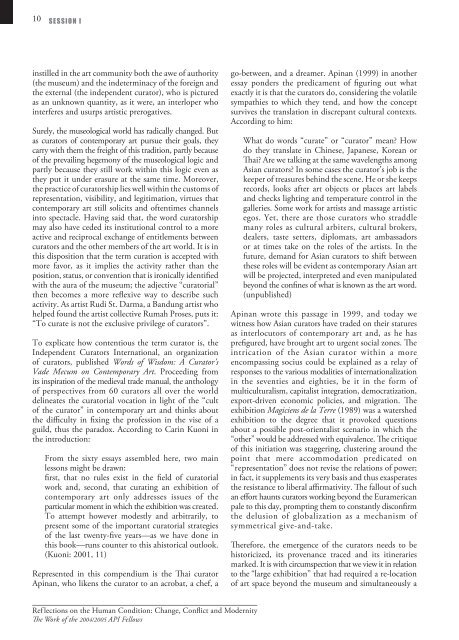Reflections on the Human Condition - Api-fellowships.org
Reflections on the Human Condition - Api-fellowships.org
Reflections on the Human Condition - Api-fellowships.org
Create successful ePaper yourself
Turn your PDF publications into a flip-book with our unique Google optimized e-Paper software.
10<br />
SESSION I<br />
instilled in <strong>the</strong> art community both <strong>the</strong> awe of authority<br />
(<strong>the</strong> museum) and <strong>the</strong> indeterminacy of <strong>the</strong> foreign and<br />
<strong>the</strong> external (<strong>the</strong> independent curator), who is pictured<br />
as an unknown quantity, as it were, an interloper who<br />
interferes and usurps artistic prerogatives.<br />
Surely, <strong>the</strong> museological world has radically changed. But<br />
as curators of c<strong>on</strong>temporary art pursue <strong>the</strong>ir goals, <strong>the</strong>y<br />
carry with <strong>the</strong>m <strong>the</strong> freight of this traditi<strong>on</strong>, partly because<br />
of <strong>the</strong> prevailing hegem<strong>on</strong>y of <strong>the</strong> museological logic and<br />
partly because <strong>the</strong>y still work within this logic even as<br />
<strong>the</strong>y put it under erasure at <strong>the</strong> same time. Moreover,<br />
<strong>the</strong> practice of curatorship lies well within <strong>the</strong> customs of<br />
representati<strong>on</strong>, visibility, and legitimati<strong>on</strong>, virtues that<br />
c<strong>on</strong>temporary art still solicits and oftentimes channels<br />
into spectacle. Having said that, <strong>the</strong> word curatorship<br />
may also have ceded its instituti<strong>on</strong>al c<strong>on</strong>trol to a more<br />
active and reciprocal exchange of entitlements between<br />
curators and <strong>the</strong> o<strong>the</strong>r members of <strong>the</strong> art world. It is in<br />
this dispositi<strong>on</strong> that <strong>the</strong> term curati<strong>on</strong> is accepted with<br />
more favor, as it implies <strong>the</strong> activity ra<strong>the</strong>r than <strong>the</strong><br />
positi<strong>on</strong>, status, or c<strong>on</strong>venti<strong>on</strong> that is ir<strong>on</strong>ically identified<br />
with <strong>the</strong> aura of <strong>the</strong> museum; <strong>the</strong> adjective “curatorial”<br />
<strong>the</strong>n becomes a more reflexive way to describe such<br />
activity. As artist Rudi St. Darma, a Bandung artist who<br />
helped found <strong>the</strong> artist collective Rumah Proses, puts it:<br />
“To curate is not <strong>the</strong> exclusive privilege of curators”.<br />
To explicate how c<strong>on</strong>tentious <strong>the</strong> term curator is, <strong>the</strong><br />
Independent Curators Internati<strong>on</strong>al, an <strong>org</strong>anizati<strong>on</strong><br />
of curators, published Words of Wisdom: A Curator’s<br />
Vade Mecum <strong>on</strong> C<strong>on</strong>temporary Art. Proceeding from<br />
its inspirati<strong>on</strong> of <strong>the</strong> medieval trade manual, <strong>the</strong> anthology<br />
of perspectives from 60 curators all over <strong>the</strong> world<br />
delineates <strong>the</strong> curatorial vocati<strong>on</strong> in light of <strong>the</strong> “cult<br />
of <strong>the</strong> curator” in c<strong>on</strong>temporary art and thinks about<br />
<strong>the</strong> difficulty in fixing <strong>the</strong> professi<strong>on</strong> in <strong>the</strong> vise of a<br />
guild, thus <strong>the</strong> paradox. According to Carin Ku<strong>on</strong>i in<br />
<strong>the</strong> introducti<strong>on</strong>:<br />
From <strong>the</strong> sixty essays assembled here, two main<br />
less<strong>on</strong>s might be drawn:<br />
first, that no rules exist in <strong>the</strong> field of curatorial<br />
work and, sec<strong>on</strong>d, that curating an exhibiti<strong>on</strong> of<br />
c<strong>on</strong>temporary art <strong>on</strong>ly addresses issues of <strong>the</strong><br />
particular moment in which <strong>the</strong> exhibiti<strong>on</strong> was created.<br />
To attempt however modestly and arbitrarily, to<br />
present some of <strong>the</strong> important curatorial strategies<br />
of <strong>the</strong> last twenty-five years—as we have d<strong>on</strong>e in<br />
this book—runs counter to this ahistorical outlook.<br />
(Ku<strong>on</strong>i: 2001, 11)<br />
Represented in this compendium is <strong>the</strong> Thai curator<br />
<strong>Api</strong>nan, who likens <strong>the</strong> curator to an acrobat, a chef, a<br />
Ref lecti<strong>on</strong>s <strong>on</strong> <strong>the</strong> <strong>Human</strong> C<strong>on</strong>diti<strong>on</strong>: Change, C<strong>on</strong>flict and Modernity<br />
The Work of <strong>the</strong> 2004/2005 API Fellows<br />
go-between, and a dreamer. <strong>Api</strong>nan (1999) in ano<strong>the</strong>r<br />
essay p<strong>on</strong>ders <strong>the</strong> predicament of figuring out what<br />
exactly it is that <strong>the</strong> curators do, c<strong>on</strong>sidering <strong>the</strong> volatile<br />
sympathies to which <strong>the</strong>y tend, and how <strong>the</strong> c<strong>on</strong>cept<br />
survives <strong>the</strong> translati<strong>on</strong> in discrepant cultural c<strong>on</strong>texts.<br />
According to him:<br />
What do words “curate” or “curator” mean? How<br />
do <strong>the</strong>y translate in Chinese, Japanese, Korean or<br />
Thai? Are we talking at <strong>the</strong> same wavelengths am<strong>on</strong>g<br />
Asian curators? In some cases <strong>the</strong> curator’s job is <strong>the</strong><br />
keeper of treasures behind <strong>the</strong> scene. He or she keeps<br />
records, looks after art objects or places art labels<br />
and checks lighting and temperature c<strong>on</strong>trol in <strong>the</strong><br />
galleries. Some work for artists and massage artistic<br />
egos. Yet, <strong>the</strong>re are those curators who straddle<br />
many roles as cultural arbiters, cultural brokers,<br />
dealers, taste setters, diplomats, art ambassadors<br />
or at times take <strong>on</strong> <strong>the</strong> roles of <strong>the</strong> artists. In <strong>the</strong><br />
future, demand for Asian curators to shift between<br />
<strong>the</strong>se roles will be evident as c<strong>on</strong>temporary Asian art<br />
will be projected, interpreted and even manipulated<br />
bey<strong>on</strong>d <strong>the</strong> c<strong>on</strong>fines of what is known as <strong>the</strong> art word.<br />
(unpublished)<br />
<strong>Api</strong>nan wrote this passage in 1999, and today we<br />
witness how Asian curators have traded <strong>on</strong> <strong>the</strong>ir statures<br />
as interlocutors of c<strong>on</strong>temporary art and, as he has<br />
prefigured, have brought art to urgent social z<strong>on</strong>es. The<br />
intricati<strong>on</strong> of <strong>the</strong> Asian curator within a more<br />
encompassing socius could be explained as a relay of<br />
resp<strong>on</strong>ses to <strong>the</strong> various modalities of internati<strong>on</strong>alizati<strong>on</strong><br />
in <strong>the</strong> seventies and eighties, be it in <strong>the</strong> form of<br />
multiculturalism, capitalist integrati<strong>on</strong>, democratizati<strong>on</strong>,<br />
export-driven ec<strong>on</strong>omic policies, and migrati<strong>on</strong>. The<br />
exhibiti<strong>on</strong> Magiciens de la Terre (1989) was a watershed<br />
exhibiti<strong>on</strong> to <strong>the</strong> degree that it provoked questi<strong>on</strong>s<br />
about a possible post-orientalist scenario in which <strong>the</strong><br />
“o<strong>the</strong>r” would be addressed with equivalence. The critique<br />
of this initiati<strong>on</strong> was staggering, clustering around <strong>the</strong><br />
point that mere accommodati<strong>on</strong> predicated <strong>on</strong><br />
“representati<strong>on</strong>” does not revise <strong>the</strong> relati<strong>on</strong>s of power;<br />
in fact, it supplements its very basis and thus exasperates<br />
<strong>the</strong> resistance to liberal affirmativity. The fallout of such<br />
an effort haunts curators working bey<strong>on</strong>d <strong>the</strong> Euramerican<br />
pale to this day, prompting <strong>the</strong>m to c<strong>on</strong>stantly disc<strong>on</strong>firm<br />
<strong>the</strong> delusi<strong>on</strong> of globalizati<strong>on</strong> as a mechanism of<br />
symmetrical give-and-take.<br />
Therefore, <strong>the</strong> emergence of <strong>the</strong> curators needs to be<br />
historicized, its provenance traced and its itineraries<br />
marked. It is with circumspecti<strong>on</strong> that we view it in relati<strong>on</strong><br />
to <strong>the</strong> “large exhibiti<strong>on</strong>” that had required a re-locati<strong>on</strong><br />
of art space bey<strong>on</strong>d <strong>the</strong> museum and simultaneously a

















